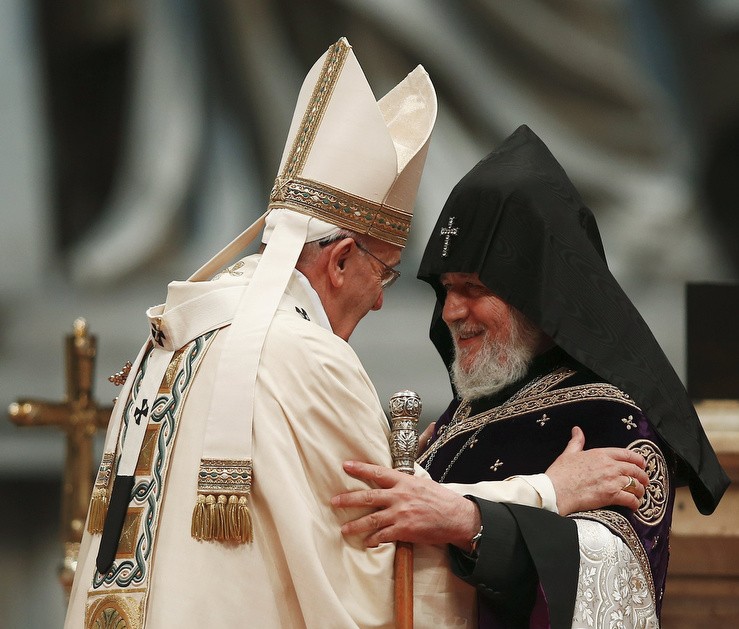
Pope Francis has last weekend quoted St John Paul II’s reference to the Armenian slaughter as ‘genocide’.
On Divine Mercy Sunday, the Second Sunday of Easter, Pope Francis celebrated Solemn Mass for the Centenary of the Armenian Martyrdom, gave a Regina Coeli address, proclaimed a new Armenian Doctor of the Church, and released a message to Armenians.
In Francis’ message to Armenians, he quotes how Pope John Paul II and Catholicos Karekin II, in a Common Declaration in 2001, referred to the massacre of 1.5 million Armenians as a genocide and went on to say how popes denounced senseless, brutal killings over time.
“This faith also accompanied and sustained your people,” he reminded them, “during the tragic experience one hundred years ago ‘in what is generally referred to as the first genocide of the twentieth century’”(John Paul II and Karekin II, Common Declaration, Etchmiadzin, 27 September 2001).
“It is the responsibility, not only of the Armenian people and the universal Church to recall all that has taken place, but of the entire human family, so that the warnings from this tragedy will protect us from falling into a similar horror, which offends against God and human dignity,” the Pontiff went on to say.
During the Mass, Francis gave a greeting to the Armenian Rite faithful in which he referred to how a Third World War is taking place “in pieces”, and criticised the world’s indifference in the face of such conflicts.
Reflecting specifically that it has been 100 years since the tragic slaughter of Amenians, the Pontiff said: “Concealing or denying evil is like allowing a wound to keep bleeding without bandaging it!”
History’s tragic events, the Pope later said in his homily – recalling those Armenians slaughtered and all murdered by Communism, Nazism, or in other mass killings – can leave us feeling “crushed” and “asking ourselves: Why?”
We ponder how we can fill the “great abyss” or “great void” created by humanity’s evil, he reflected. It is impossible for us to do so, he said, stressing that only God “can fill this emptiness that evil brings to our hearts and to human history”.
“Behold the way which God has opened for us to finally go out from our slavery to sin and death, and thus enter into the land of life and peace,” he told the faithful.
The Pontiff then turned to how St John’s Gospel recalls how Jesus dispelled Thomas’ doubt of His having resurrected in the Upper Room, and what this means for our lives.
“Jesus invites us to behold these wounds, to touch them as Thomas did, to heal our lack of belief,” he said. “Above all, he invites us to enter into the mystery of these wounds, which is the mystery of His merciful love.”
Through these wounds, he noted, we can see the entire mystery of Christ and of God and can retrace the whole history of salvation.
“The saints teach us that the world is changed beginning with the conversion of one’s own heart, and that this happens through the mercy of God,” he said.
So, if our consciences are distressed or we are in turmoil over the world’s tragedies, Francis said, we must remember that “there is no sin so deadly that it cannot be pardoned by Christ’s death”.
Maintaining our gaze on the wounds of the Risen Jesus and allowing the Lord to lead the way, we will find life and hope, Pope Francis said.
Keeping in line with Sunday tradition, the Pope gave his Regina Coeli address to the pilgrims in a sunny St Peter’s Square at noon. In addition to reflecting on the Gospel and on God’s infinite mercy, the Holy Father offered Easter greetings to all Christians who follow the Julian calendar.
Armenian Doctor of the Church
The Holy Father also used the occasion to proclaim the great Armenian, St Gregory of Narek, a Doctor of the Church, a special designation that recognises doctrinal insights in the writings and teachings of certain saints.
The 10th-century Armenian monk will be the 36th Doctor of the Church, joining the list which includes St Augustine and St Francis de Sales.
Born in 950 AD, Gregory would be known for his poetic writings and commentaries and is revered as one of the great figures of Armenian religious thought.
The Book of Lamentations, his book of prayers, is considered one of his great masterpieces and still considered as a definitive piece of Armenian literature.